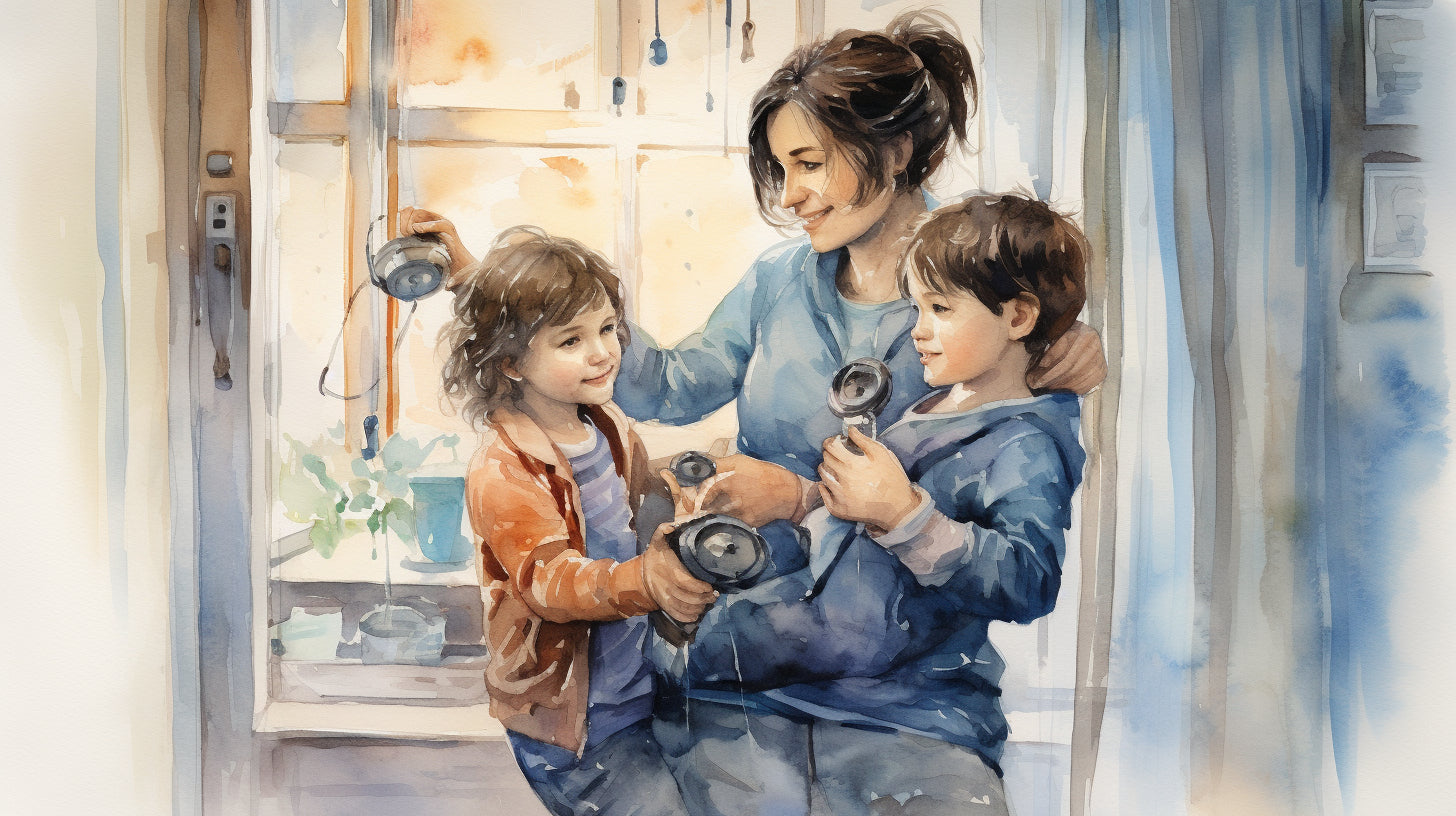Assessing Home Security Measures
When it comes to ensuring the safety of your household as a stay-at-home mom, one of the first things you should do is assess your home security measures. By evaluating the existing security system and implementing additional measures, you can create a protected living environment for you and your family. Here are some important steps to take:
Evaluating the Current Security System
Start by assessing the effectiveness of your current security system, if you have one. Consider factors such as:
- Is the system functioning properly? Are there any malfunctions or issues?
- Does the system cover all entrances and vulnerable areas, such as windows and back doors?
- Are the security cameras, alarms, and sensors in good working condition?
If you don't have a security system in place yet, consider investing in one. A security system can provide peace of mind and act as a deterrent to potential burglars.
Securing Doors and Windows
The next step is to ensure that all doors and windows are properly secured. Here are some measures you can take to enhance their security:
- Install sturdy locks on all doors, including deadbolt locks for added protection.
- Reinforce the door frames and hinges to make it harder to break in.
- Consider installing window locks or security film on windows to prevent unauthorized access.
Additionally, consider installing a peephole or video doorbell system so you can see who is at your doorstep before opening the door.
Installing Outdoor Lighting
Well-lit exteriors can deter criminals and improve overall safety. Here are a few tips for installing outdoor lighting:
- Place motion sensor lights near entrances and dark corners of your property. These lights will automatically turn on when they detect movement.
- Illuminate pathways and walkways leading up to your home.
- Install lights with timers to make it appear as though someone is home, even when you're away.
Remember, a well-lit exterior can make your home a less attractive target for burglars.
By assessing and implementing these home security measures, you can significantly enhance the safety of your household. Don't underestimate the importance of taking steps to protect your home and family. In the next section, we will discuss implementing safety practices that go beyond physical security. So, let's move on to the next section and learn about these practices.
Implementing Safety Practices
As a stay-at-home mom, it's crucial to prioritize the safety of your household. Implementing safety practices not only ensures the well-being of your family but also creates a sense of security and peace of mind. Here are some essential safety measures you can easily implement in your home:
1. Creating and Practicing a Home Emergency Plan
Having a well-thought-out emergency plan is essential for any household. Here are some steps to create and practice a home emergency plan:
- Identify the potential risks and hazards in your home, such as fire, natural disasters, or medical emergencies.
- Create a plan that includes designated meeting spots, escape routes, and a communication strategy.
- Discuss the emergency plan with your family members and ensure that everyone understands their roles and responsibilities.
- Conduct regular drills to ensure that everyone knows what to do in case of an emergency.
Remember, practice makes perfect, so it's crucial to review and update your emergency plan regularly to account for any changes in your household or living conditions.
2. Teaching Children Personal Safety
One of the most important aspects of ensuring a protected household is teaching your children about personal safety. Here are some key topics to cover:
- Stranger danger: Educate your children about who they can trust and the importance of never talking to strangers or accepting gifts from them.
- Boundaries and personal space: Teach your children about respecting personal boundaries and saying "no" if they ever feel uncomfortable.
- Road safety: Teach your children basic road safety rules, such as looking both ways before crossing the street, using pedestrian crossings, and wearing reflective gear when it's dark outside.
- Internet safety: Teach your children about online safety, including the importance of not sharing personal information, not talking to strangers online, and using privacy settings on social media.
3. Preventing Accidents and Injuries
Accidents can happen at any time, but there are steps you can take to minimize the risk. Here are some safety measures to prevent accidents and injuries in your home:
- Childproofing: Ensure that your home is childproofed by installing safety gates, securing furniture to the wall, covering electrical outlets, and keeping toxic substances out of reach.
- Fire safety: Install smoke detectors on each level of your home and regularly check that they are working. Teach your children about fire safety, including the "stop, drop, and roll" technique.
- Kitchen safety: Keep sharp objects and potentially hazardous substances locked away. Teach your children about the dangers of playing with kitchen appliances and utensils.
- Stair safety: Install sturdy handrails and non-slip treads on staircases. Teach your children to always use the handrail and take one step at a time.
By implementing these safety practices, you'll be taking proactive steps to protect your family and create a home environment that prioritizes their well-being. Remember, it's essential to stay vigilant and consistently reinforce these safety measures as your children grow and learn. Stay safe!
Smart Home Technology for Added Security
In today's digital age, technology has made it easier than ever to enhance the security of our homes. With the advancements in smart home technology, stay-at-home moms can take advantage of various devices and systems to provide an additional layer of protection for their households. These innovative solutions not only provide peace of mind but also offer convenience and ease of use. Let's explore some of the smart home technology options available for added security:
Exploring Surveillance Camera Options
- Surveillance cameras are an integral part of any home security system. They allow you to monitor your property remotely and deter potential intruders.
- Wireless cameras are easy to install and offer flexibility in terms of placement. You can keep an eye on your home using your smartphone or tablet, even when you're not there.
- Outdoor cameras with weatherproof features are designed to withstand harsh weather conditions, ensuring constant surveillance regardless of the season.
- Indoor cameras can be used to keep an eye on children or elderly family members, providing an added sense of security.
- Motion-detection cameras can send you alerts whenever movement is detected, allowing you to respond quickly if there is any suspicious activity.
Using Smart Doorbell Systems
- Smart doorbell systems, such as video doorbells, have gained popularity in recent years. These devices come equipped with cameras, motion sensors, and two-way audio capabilities.
- When someone rings your doorbell, you can see who is at your door through a live video feed on your smartphone. This feature is especially useful for stay-at-home moms, as it allows you to assess who is outside before opening the door.
- Some smart doorbells also have the option to record video clips of any activity outside your door, providing valuable evidence in case of an incident.
Integrating Home Automation
- Home automation technology can be integrated with your security system to create a truly smart home. This technology allows you to control various aspects of your home remotely.
- With smart locks, you can secure your doors using your smartphone. You no longer need to worry about forgetting to lock the doors when leaving the house.
- Smart lighting systems enable you to program your lights to turn on and off at specific times, giving the illusion that someone is always home, even when you're away.
- By integrating your security system with other smart devices in your home, such as voice assistants or smart thermostats, you can create a comprehensive and convenient home security ecosystem.
Investing in smart home technology not only provides enhanced security but also offers convenience and peace of mind for stay-at-home moms. These intuitive devices and systems not only act as a deterrent for potential intruders but also provide real-time monitoring and alerts for any suspicious activity. With the ability to control your home remotely, you can rest assured that your family and belongings are safe at all times. So take advantage of these technological advancements and make your home a smarter and safer place.
Maintaining Online and Digital Safety
As a stay-at-home mom, ensuring the safety and security of your household goes beyond just physical measures. In today's digital age, it is crucial to also prioritize online and digital safety for yourself and your family. Here are some tips to help you maintain online and digital safety:
1. Protecting Personal Information Online
When you are online, it's important to be cautious about sharing personal information. Here are some practices to keep in mind:
- Think before you share: Be mindful of the information you share online, such as your address, phone number, or social security number. Only provide this information on trusted and secure websites.
- Use strong and unique passwords: Create strong passwords for your online accounts and avoid using the same password for multiple accounts. Make sure to include a mix of uppercase and lowercase letters, numbers, and special characters.
- Enable two-factor authentication: Many online platforms offer two-factor authentication, which adds an extra layer of security to your accounts. Enable this feature whenever possible to protect your personal information.
2. Teaching Children about Online Safety
As a parent, it's important to educate your children about online safety. Here are some tips to help keep them safe online:
- Set rules and boundaries: Establish rules for internet use and ensure your children understand the importance of following them. For example, you can set limits on screen time or prohibit sharing personal information online.
- Monitor their online activity: Keep an eye on your children's online activities and be aware of the websites they visit and the people they interact with. Install parental controls or use monitoring software to help you with this.
- Teach them about online predators: Educate your children about the risks of communicating with strangers online and the importance of never sharing personal information with someone they don't know in real life.
3. Securing Home Wi-Fi Network
Your home Wi-Fi network can be vulnerable to cyberattacks if not properly secured. Here are some steps to ensure the security of your home network:
- Change default passwords: When setting up your Wi-Fi router, make sure to change the default username and password to something unique and strong.
- Enable network encryption: Enable WPA2 (Wi-Fi Protected Access 2) encryption on your Wi-Fi network to protect it from unauthorized access. This can usually be done through your router's settings.
- Update firmware regularly: Keep your router's firmware up to date to ensure that it has the latest security patches. Check your router manufacturer's website for firmware updates.
By following these practices, you can help maintain the online and digital safety of your household. Remember, it's important to stay vigilant and regularly update your security measures to keep up with the ever-evolving threats in the online world.
Self-Defense Strategies for Stay-at-Home Moms
As a stay-at-home mom, ensuring your personal safety is crucial for maintaining a protected household. While we may not like to think about it, emergencies can happen at any time. Being prepared and equipped with self-defense strategies can give you peace of mind and empower you to handle potentially risky situations. Here are some self-defense strategies that stay-at-home moms can implement:
Learning Basic Self-Defense Techniques
Knowing how to defend yourself physically is essential in case you ever find yourself in a dangerous situation. Consider enrolling in a self-defense class specifically designed for women. These classes will teach you basic techniques to protect yourself, such as:
- Learning how to use body strikes effectively
- Practicing escapes from grabs and holds
- Discovering techniques to deter or fend off attackers
Attending these classes not only equips you with important skills but also boosts your confidence, making you feel more secure in your daily life.
Utilizing Personal Safety Apps
In today's digital age, personal safety apps can be an additional layer of protection for stay-at-home moms. These apps provide features that can help you feel safer whether you're at home or out running errands:
- SafeWalk: This app enables you to invite friends or family members to virtually accompany you by sharing your location. If you're walking alone, they can monitor your journey and make sure you arrive safely at your destination.
- bSafe: With features like a network of friends or family who can track your movements, an SOS alarm, and a fake inbound call, bSafe is an app that focuses on keeping you safe and connected.
- Circle of Six: This app allows you to quickly alert your selected contacts in case of an emergency. It also provides resources for safety information and support.
Adding personal safety apps to your smartphone can be a valuable tool for enhancing your overall security.
Enhancing Awareness and Avoiding Risky Situations
One of the most effective self-defense strategies is being aware of your surroundings and avoiding potentially risky situations altogether. Here are some tips to help you enhance your awareness and stay safe:
- Trust your instincts: If something feels off or makes you uncomfortable, listen to your intuition and remove yourself from the situation.
- Plan your outings: Before leaving the house, research the areas you'll be visiting. Be aware of any safety concerns or recent incidents in those locations.
- Stay vigilant: Pay attention to your surroundings, especially when walking alone or in unfamiliar places. Put away distractions like your phone and maintain good visibility of your surroundings.
- Establish boundaries: Clearly communicate your personal boundaries to others, whether it's strangers or acquaintances.
Remember, self-defense is not just about physical techniques; it's also about avoiding dangerous situations whenever possible.
By learning basic self-defense techniques, utilizing personal safety apps, and enhancing your awareness, you can enhance your personal safety as a stay-at-home mom. These strategies will equip you with the knowledge and tools to handle potentially risky situations and maintain a protected household. Stay tuned for more valuable tips on ensuring personal safety as a stay-at-home mom!
Staying Connected and Building Support Networks
Being a stay-at-home mom can sometimes feel isolating, but it doesn't have to be that way. Building a strong support network and staying connected with other moms can not only help you combat feelings of loneliness but also provide you with valuable resources and support. Here are some ways to stay connected and build support networks as a stay-at-home mom:
-
Joining Local Parenting Groups
Look for local parenting groups in your area. These groups often have regular meetups, playdates, and activities for moms and their children. It's a great way to make new friends, share experiences, and find support from others who are going through similar experiences.
-
Attending Self-Defense or Safety Classes
Consider taking self-defense or safety classes specifically designed for women. Not only will you learn essential self-defense techniques, but you'll also have the opportunity to meet other moms who are interested in staying safe and protecting their families.
-
Accessing Online Support Communities
There are numerous online communities and forums specifically created for stay-at-home moms. These platforms provide a space where you can connect with other moms, ask questions, seek advice, and share your own experiences. It's a virtual support network that is available to you 24/7.
Building a support network is not just about having someone to talk to; it's about finding a community of like-minded individuals who can be there for you when you need it the most. The benefits of staying connected and building support networks as a stay-at-home mom are many:
-
Emotional Support: Having other moms who can relate to your experiences can be incredibly comforting and provide emotional support. You can share your joys, frustrations, and concerns in a judgment-free environment.
-
Practical Advice: Other moms can offer practical advice and tips on a variety of topics such as childcare, meal planning, organization, and more. You can learn from their experiences and gain new insights that can make your life easier.
-
Sharing Resources: By being part of a support network, you can tap into a wealth of resources. Whether it's borrowing baby gear, exchanging books and toys, or getting recommendations for trusted service providers, having access to a network of moms can save you time and money.
-
Opportunities for Socialization: Stay-at-home moms often miss out on the social interaction that comes with working outside the home. Being part of a support network gives you the chance to socialize, make friends, and create lasting relationships with other moms and their children.
-
Collaboration and Skill-Sharing: Your support network can also be a platform for collaboration and skill-sharing. You can team up with other moms to organize playdates, childcare co-ops, or even start a small business together. The possibilities are endless when you have a community of supportive moms.
Remember, building a support network takes time and effort. Be proactive in reaching out to other moms, attending events, and participating in conversations both online and offline. The more you put yourself out there, the more opportunities you'll have to connect with other moms who can provide the support and friendship you need.
Emergency Preparedness for Stay-at-Home Moms
As a stay-at-home mom, it's essential to prioritize the safety of your household, especially when it comes to emergency preparedness. By being proactive and taking steps to ensure the well-being of your family, you can effectively handle any unforeseen situations that may arise. From stocking essential supplies to creating a first aid kit, here are some key strategies to help you be prepared for emergencies as a stay-at-home mom.
Stocking Essential Supplies
Having a well-stocked pantry and emergency supplies is crucial in case of emergencies. As a stay-at-home mom, you have the advantage of being able to regularly monitor your household's supplies and stock up as needed. Here are some essentials to consider:
- Non-perishable food items: Keep a supply of non-perishable food items such as canned goods, dried fruits, and nuts. These items have a long shelf life and can sustain your family during emergency situations.
- Bottled water: It's important to have an ample supply of clean drinking water in case of water disruptions or contamination. Aim for at least one gallon of water per person per day, and have enough to last your family for a minimum of three days.
- Medications and first aid supplies: Ensure that you have an adequate supply of medications for each family member. Additionally, have a well-stocked first aid kit with bandages, antiseptic ointment, pain relievers, and any necessary prescription medications.
- Batteries and flashlights: Power outages can occur during emergencies, so it's essential to have a supply of batteries in different sizes for flashlights and other essential devices.
- Personal hygiene items: Remember to stock up on essential personal hygiene items such as toilet paper, feminine hygiene products, diapers, and baby wipes.
Creating a First Aid Kit
A well-prepared first aid kit is a must-have for any stay-at-home mom. Having the necessary medical supplies readily available can help you provide immediate aid during emergencies. Here are some items to include in your first aid kit:
- Bandages in various sizes
- Antiseptic wipes or solution
- Adhesive tape
- Gauze pads and rolls
- Tweezers and scissors
- Disposable gloves
- Instant cold packs
- Thermometer
- Pain relievers and fever reducers
- Prescription medications
- CPR mask
- Emergency contact information, including phone numbers of doctors, poison control, and emergency services
Remember to regularly check and replenish your first aid kit to ensure that all supplies are within their expiry dates.
Knowing Emergency Contact Information
In emergency situations, having quick access to important contact information is crucial. Make sure to have a list of emergency contact numbers readily available, including:
- Local emergency services: Keep the phone numbers of the local police, fire department, and hospital easily accessible.
- Doctor's contact information: Have the contact details of your family physician or pediatrician readily available for any medical emergencies.
- Poison control: Keep the poison control hotline number in a visible place, as accidents can happen, especially when you have young children at home.
It's important to not only have this information stored on your phone but to also have a printed copy posted in a visible area of your home, such as on the refrigerator.
By following these emergency preparedness strategies, stay-at-home moms can ensure the safety and well-being of their households. Remember to regularly review and update your emergency plans, supplies, and contact information to remain prepared for any situation that may arise.
Conclusion
In conclusion, as a stay-at-home mom, ensuring the safety and security of your household should be a top priority. By assessing your home security measures, implementing safety practices, utilizing smart home technology, maintaining online and digital safety, learning self-defense strategies, staying connected with support networks, and being prepared for emergencies, you can create a protected environment for you and your family.
Remember, personal safety is crucial, and it's important to take proactive steps to prevent any potential dangers. At Empowered by Ashley, we understand the importance of feeling safe and secure. That's why we offer a range of personal safety products designed to empower and protect individuals in various situations.
One of our best-selling products is the Personal Safety Alarm. With its loud, attention-grabbing sound, this compact device is designed to deter attackers and alert others in case of an emergency. Its portable and easy-to-use design makes it ideal for stay-at-home moms who want an added layer of protection.
To learn more about our products and how they can enhance your personal safety and security, visit our website at empoweredbyashley.com. Remember, prioritizing your safety is not only important for you but also for the well-being of your entire family. Stay empowered and stay safe!
Frequently Asked Questions
-
What are some personal safety tips for stay-at-home moms?
Some personal safety tips for stay-at-home moms include: 1. Keep doors and windows locked at all times, 2. Install a security system or surveillance cameras, 3. Practice proper home fire safety measures, 4. Be cautious when opening the door to strangers, 5. Learn basic self-defense techniques.
-
How can stay-at-home moms protect their children from potential dangers?
Stay-at-home moms can protect their children from potential dangers by: 1. Childproofing the home, 2. Teaching children about stranger danger, 3. Setting boundaries and rules for online safety, 4. Supervising outdoor playtime, 5. Educating children about emergency procedures.
-
What are some essential safety devices every stay-at-home mom should have in their home?
Some essential safety devices for stay-at-home moms include: 1. Smoke detectors on every floor, 2. Carbon monoxide detectors, 3. Baby gates for staircases, 4. Outlet covers, 5. First aid kits.
-
How can stay-at-home moms create a secure environment for themselves and their family?
Stay-at-home moms can create a secure environment by: 1. Establishing a routine for locking doors and setting security alarms, 2. Keeping personal information private, 3. Being cautious about sharing information on social media, 4. Knowing their neighbors and developing a community network, 5. Having emergency contacts readily available.
-
What should stay-at-home moms do in case of an emergency?
In case of an emergency, stay-at-home moms should: 1. Have a well-stocked emergency kit with essential supplies, 2. Know how to perform basic first aid, 3. Teach children how to call emergency services, 4. Have an emergency plan in place, 5. Stay calm and follow the necessary protocols.





















Leave a comment
This site is protected by hCaptcha and the hCaptcha Privacy Policy and Terms of Service apply.